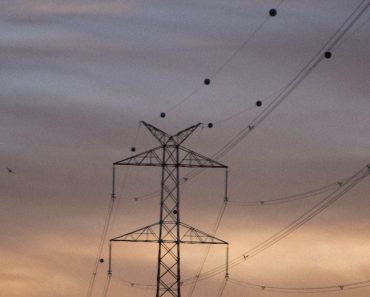Oh, so this is what those balls on high voltage cables mean
Did you already know what the purpose of these balls is?
They are almost impossible to miss if you look up: brightly colored balls on the power lines. They look like Christmas balls! They all hang evenly apart and provide a bit of color to something gray like the high-voltage cables. But they aren’t there just for show – the balls have a purpose! We explain it to you.
When these balls first appeared on the power grid is not entirely clear. The practice probably started in the US. There are two states that seem to have come up with the idea: Arkansas and Florida. They say this custom started in the 1950s. But nowadays you see them everywhere!
Want to know why?
Bigger than you think!
If you drive along a couple of power lines, or if you just look at them from the ground, these balls don’t look very big. You might think they’re about the size of a basketball. But nothing is farther from the truth! These balls are a lot bigger than you think. The reason we think they are so small is because there is quite a bit of distance between the ground and the cable. The larger variants have a diameter of about 91 centimeters.
Good system
It’s not an easy task installing the balls. Various organizations are involved, and it is necessary to coordinate exactly which balls will be placed where. And there are plenty of professionals involved. Some of them work on the ground, but some work at a great height to assemble the balls onto the electricity grid.
Do you know what these people are doing at high altitude?
Electricity
We’ll give you a tip: it all has to do with the electricity that runs through these cables. Did you know that it has only been possible to transport electricity over such long distances since 1882? It was then that engineers Oskar von Miller and Marcel Deprez managed to carry electricity over a longer distance. Very clever indeed: they used high-altitude cables for this, which were actually used for sending telegram messages. The duo then managed to transport 2.5 kilowatts over 60 kilometers. Today, of course, that distance means nothing anymore: our technology is now so advanced that we lay cables across national borders and on the bottom of the ocean.
Before Miller and Deprez’s invention, electricity could only be transported locally. But as the demand for electricity increased, power plants had to get increase in size and they no longer fit into the towns and cities they served.
Know how this was resolved?
Cables in the air
The high-voltage cable was therefore invented to ensure that power could reach everyone. A special fact is that the cables you see hanging in the air are not insulated. Well, why would they be, if no one actually ever touches them?
Accidents happen easily
With so many uninsulated cables, things can sometimes go very wrong. That really only happens when the cables come into contact with each other, or when the cables make contact with the ground in some way. You’ve probably seen a photo or video of that happening before.
However, this also posed a problem for birds who very much like resting on the cables.
Birds
Good: a lot has to go wrong for real fireworks to happen with such a high-voltage cable. As long as the electricity remains within the cables and cannot make contact with the ground or other cables in the vicinity via another way, there is nothing to worry about.
And therefore birds can safely take a nap on the life-threatening cables! After all, they are in no way in touch with the ground. However, birds could face terrible consequences if they’d accidentally stroke their tail along a second cable. Or if the bird is in contact with both the cable and the construction planted in the ground at the same time.
Safe for birds
Today, however, in many countries the high-voltage cables are made in such a way that birds can land safely. By increasing the space between the cables, the chance that a sparrow or gull will succeed in electrocuting itself is much smaller. Of course really big birds could still be a problem, but there’s only so much you can do. You don’t see them on a high-voltage cable often anyway.
Shoes on high voltage cables
Aside from birds, you have probably also seen a pair of shoes on a high-voltage cable before. Or on some other kind of cable hanging over a street somewhere. One day nothing is wrong, and the next day you open your curtains and suddenly find yourself looking out at a pair of sneakers waving in the wind from a high-voltage cable. Why does that happen so often?
6,000 pairs of shoes
You may not see them very often in the Netherlands, but in the American metropolis of Chicago you can see shoes hanging in many places. Between 2008 and 2015, the municipality had to remove no fewer than 6,000 pairs of shoes from the cables!
Who do you think is responsible for throwing those shoes?
Drugs, gangs, and crime?
According to some, the shoes have to do with territorial conflicts between different criminal gangs. Now you will not see that often in the Netherlands. Another story that goes around a lot is a pair of shoes indicate a place where you can buy drugs. Creepy!
Much more realistic
In the Netherlands, however, there is a good chance that the shoes are just a prank. You will be able to spot the shoes after a night out, especially in student-rich cities. One minute you’re wandering home with your friends, the next you find yourself involved in a shoe-throwing contest.
Of course those shoes don’t belong on such a cable. But there are many things on our high-voltage cables that do belong there!
Glass discs
Close to electricity pylons you often see glass discs hanging from high-voltage cables. These also have a special purpose!
Curious to find out what these things are for?
Electricity pylons
We just mentioned that it is extremely important for the voltage in the cables that they do not make contact with the ground. That would result in fireworks. Yet those cables hang from the gigantic electricity pylons that you see everywhere and nowhere. That’s where those glass discs come into play.
Thunder and lightning
The high voltage cables are of course not the only work of electricity hanging in the air! Clouds can also cause a lot of fireworks when it storms. The result: bright flashes of electricity. By providing the high-voltage cables with the glass sheaves, the lines are also protected against lightning striking the mast. So don’t worry about those during the next thunderstorm!
Colored balls
Well, those glass disks aren’t that easy to see from afar, important as they are. However, the colored balls on the high-voltage cables can be spotted from a great distance. Take a look below to see how big they are: then you will immediately understand why they are still recognizable from hundreds of meters away. In the past mainly red balls were used, but nowadays orange is the standard. You will undoubtedly be able to spot the balls in different colors if you really pay attention.
Where do you see them most often?
In general, the balls are roughly 60 meters apart. However, there is one place where you can spot them much more often than that: near an airport. And in that fact lies the biggest hint as to their purpose. According to one of the stories circulating about their invention, the balls were invented in Arkansas. The coastal state of Florida would therefore have nothing to do with it!
What do you think? What are they for?
The origin
According to one version about the origin of the balls that you so often see on high-voltage cables, the man below has something to do with it. If you don’t recognize him, don’t worry, he’s the former governor of the US state of Arkansas. You couldn’t have known, of course. The story goes that he was in an airplane in the fifties, and got the fright of his life!
Without a scratch
Suppose you are on an airplane. You’ve had a smooth flight, and the pilot is getting ready to land the plane again. But then, when you look out the window, you see a shocking image. Only a few meters from your plane, you see a set of high-voltage cables. So dangerous!
Safety before anything else
So that’s exactly what happened to the Governor of Arkansas. Winthrop Rockefeller was shocked to find that the pilot was flying narrowly close to a set of power lines as he landed his plane. Remember that these cables are not insulated, and even the slightest touch can therefore be disastrous. Rockefeller had barely recovered from the shock when he decided that everything could be improved by a lot.
Warning
This is how the balls on the high-voltage cables once started: as a great warning sign for upcoming pilots. “Beware!” is what the balls are meant to say. “You can’t just fly through here!” However, that did not immediately lead to improvements everywhere. After all, Winthrop was governor of Arkansas, but had nothing to say in other American states. Nothing changed there until a tragic accident happened.
Want to know what happened before things started to change?
Drama in Colorado
In the American state they soon started installing the warning system on the electricity cables. However, it turned out not to have been fast enough. At the end of the 1980s, a terrible accident took place.
Accident in 1988
In 1988, a news helicopter takes to the skies in Colorado. On board are two journalists as they fly across the South Platte River. What they do not see, however, is that there is a thin cable hanging about 45 meters above the river. Unfortunately, the helicopter pilot did not see the cable coming either. He couldn’t prevent an accident and unfortunately both journalists lost their lives. However, it does not stop here.
Curious about how the cables affect pilots?
‘Almost impossible’
About fifteen years later, pilot magazine FAAviation News published an article in which helicopter pilots complained about high-voltage cables. They said they are very difficult to see. Estimating distance to the cables is almost impossible, and various causes can lead to problems. Among other things, “dirty windows, lighting conditions, changes in terrain or cables, and other optical illusions” could lead to problems, especially during takeoff and landing. But you can also spot the balls on the high-voltage cables in other places.
Natural areas
In the Netherlands things are pretty flat. The only real mountain we have is the Limburg Vaalserberg, and we don’t have cliffs and valleys either, not to mention canyons. In America, of course, it’s a bit different. There the nature is rough and the landscapes are even rougher. From mountains to canyons: there is quite a difference in height. And now and then helicopters fly there. After all, the area is not always easily accessible by car, but from the air you can get to just about anywhere.
Mountain pass to valley
In many places between the North American flora and fauna you can regularly see the brightly colored balls hanging in the sky. This prevents accidents from happening in places where helicopter pilots have to fly low. Did you know that very specific balls are used for this?
What do you think the balls in the canyons look like?
Small balls, big balls
In canyons, over lakes, in large nature reserves: that’s where the balls are the biggest. This is where the cables are most likely to be overlooked and the markers are most useful. This is why you will find balls over 90 centimeters wide over these types of areas. Moreover, in these types of areas the cables have balls along their entire length. After all, it is difficult to predict in advance where and when a helicopter will ascend or descend in rough areas. At airports the situation is different.
Curious to find out about airports?
Landing strip
We just explained the importance of the markers at airports. There is also quite a lot going on in terms of landing and taking-off, and the entire operation is geared towards allowing air traffic to pass through. Have you ever looked out the window as you were flying over an airport? It truly is a spectacle of lights!
Smaller than you think
At airports, the balls are a lot smaller. At the end of the runway, for example, you can see balls hanging approximately 50 centimeters above the ground. This is the same size used elsewhere in the country for high-voltage cables suspended 15 meters high or lower. It’s hard to believe that these cables hang so close to the ground, isn’t it? The balls also have another function at the airports. What do you think that function is?
Air traffic
Soon, when you are in your car, count how many traffic signs you see within about 200 meters around you. We can promise you that there are more than you think! Pilots also have to pay attention to many things when they taxi over an airport. Of course at airports you see plenty of lights, markings painted on the runway, signs… and those colored balls!
Traffic sign
Yes, you read that right: those balls also function as traffic signs. At the end of the runway they hang closer together. It is a warning to an approaching pilot: “Watch out! The runway ends here!” is their message. Just like with traffic signs, the balls also have different colors. There are also rules. Which different colors have you seen?
Curious to find out what the different colors mean?
Visibility
As mentioned before, it started with red balls. Very clearly visible, you would think. But the result turned out to be disappointing. They switched to orange balls. Research by the American flight authorities showed that they are much more visible to pilots. You can imagine that the bright orange stands out more in the dark than a red ball. After all, the ultimate goal is that pilots can see where they are flying. And that is why the flight authorities have rules in place for this.
A color for every environment
But an orange ball is not always easily visible in all places. For example, think about all the places in the U.S. where you can see the well-known rust-brown rock in mountains and valleys? Against such a background, an orange ball is not very useful at all. That is why the rule is to pick the color that is most fitted for a specific environment. As a result, you can see red, orange, yellow, and even white balls dangling from the lines.
One more rule
In addition, there is another rule for the color of the balls. This depends on the number of balls hanging from the cable. After all, when a high-voltage cable is very short, there are only a few balls hanging from the cable. But a longer cable can run for miles, so what do you do in that situation? After all, there is a good chance that the landscape through which the cable runs changes as you move along the cable.
Game
It’s almost like a game, those balls dangling from the cables. Especially when you hear what the rule is for all those markings on shorter cables. There the rule applies that four or fewer balls in a row must all have the same color. And the number of balls in a row is determined by how long the cable is.
Other benefits
In short: the balls have done a lot of good since they were first introduced, so it’s no surprise that there seems to be a lot of hard work behind it. Additionally: it appears that the cables are now less of a problem for geese and captains of larger boats as well. Great news!
Don’t care about balls
In short, those balls might draw a little more attention to something as ugly as a power cable, but that’s exactly their purpose. The next time you’re on an airplane, you can thank those balls. After all, they make life a lot easier for your pilot. And now that you know exactly what’s going on, you can tell your fellow passengers exactly what’s going on with those crazy colored balls on the high-voltage cables for the rest of your flight.
Source: Affluent Times | Image: Pixabay







